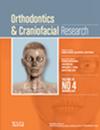The morphology of alveolar bone of the mandibular second and third molars in skeletal Class III patients
Abstract
Objectives
To investigate the alveolar bone morphology of the mandibular second and third molars in skeletal Class III patients from a buccolingual direction.
Methods
Sixty skeletal Class III patients were recruited. The alveolar bone width, buccal cortical bone thickness and lingual cortical bone thickness were measured in five planes from mesial to distal and at five depths from gingival to root. The effects of the gender of the patients, the second molar lingual inclination and the third molar on alveolar bone width and cortical bone thickness were evaluated. To explore the effect of third molar extraction on alveolar bone morphology, the measurements before and after third molar extraction were compared.
Results
The impacted third molar had significantly greater alveolar bone width and thicker buccal cortical bone at the cervical third of the molar, while the erupted third molar had greater alveolar bone width at the apical third. Three weeks after third molar extraction, these advantages would weaken owing to the reconstruction of the alveolar bone. Patients with lingually inclined molar were observed to own thicker lingual cortical bone. Males tended to have greater alveolar bone width, but no significant differences were shown in this study.
Conclusions
The growth of the third molar and the second molar lingual inclination affect the alveolar bone morphology of the mandibular second and third molars significantly, but gender has trivial effects on the morphology. The alveolar bone morphology of the mandibular second and third molars would change 3 weeks after third molar extraction.

 求助内容:
求助内容: 应助结果提醒方式:
应助结果提醒方式:


